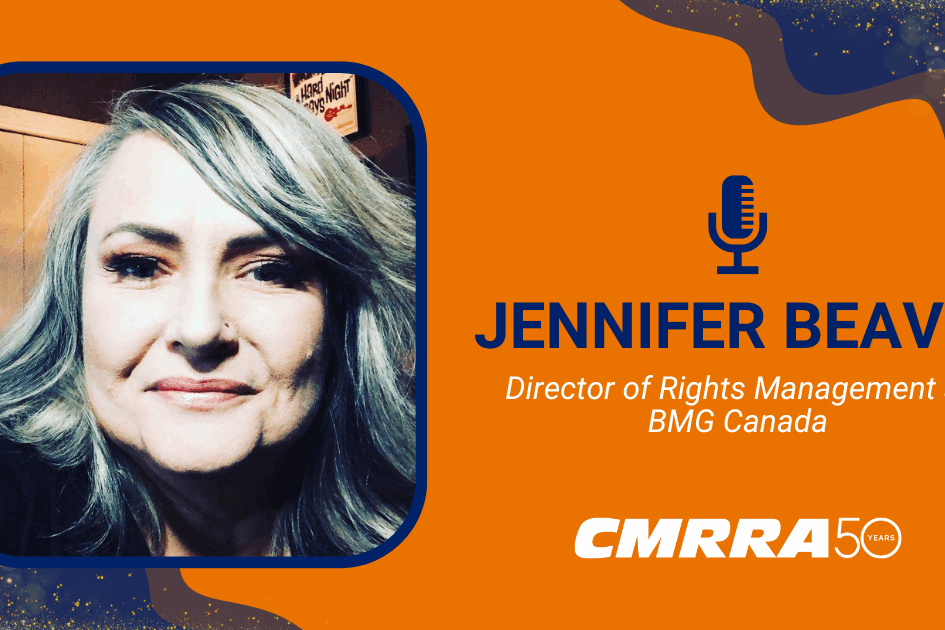By Isabelle Speerin
Fifty years ago, a forward-thinking group of Canadian music publishers led by Pierre Gauthier, President of the Canadian Music Publishers Association (CMPA), laid the groundwork for the creation of an organization to oversee the licensing of musical reproduction rights in Canada. CMPA’s mission was to promote the interests of music publishers and their songwriting partners through advocacy, communication, and education. Motivated by the need for a collective voice, they founded the Canadian Musical Reproduction Rights Agency (CMRRA) in 1975, creating an agency that would centralize the licensing of music in Canada.
Key industry figures Cyril Devereux and Al Mair were instrumental in shaping CMRRA’s growth and impact. Both played pivotal leadership roles, with Devereux as General Manager, and Mair as President and Board Director for several decades. Their combined experience helped CMRRA navigate the end of the compulsory licensing era and statutory mechanical rate in Canada in 1988, opening the door to direct market negotiations with the record industry and substantially higher royalty rates in the region.
In its formative years, CMRRA managed mechanical licenses for physical products, chiefly vinyl records, cassettes, and CDs that dominated the 70s, 80s, and 90s. The rise of digital music platforms like iTunes and peer-to-peer file sharing networks in the early 2000s led to an urgent need for new licensing frameworks. CMRRA responded by advocating for the right to license musical works directly to online music platforms and ultimately expanded its licensing activities to include digital music distribution. This shift was pivotal in ensuring clients could receive fair compensation for their works. Today, CMRRA stands as Canada’s leading authority in both digital and physical mechanical licensing, although its true strength lies in its ability to reinvent itself to stay ahead of the evolving music industry. This ability to adapt and innovate has been central to the agency’s longevity within the Canadian music ecosystem. Some key milestones that have solidified CMRRA’s position as an industry leader over the past five decades include:
• In 1997, amendments to the Copyright Act, driven in part by CMRRA’s advocacy efforts, allowed CMRRA to pursue a new revenue source for music publishers by proposing a broadcast mechanical tariff, requiring commercial radio broadcasters to pay royalties for their reproductions of copyrighted works. This tariff has since generated more than $150 million for Canadian music publishers.
• CMRRA played a key role in the establishment of the Canadian Private Copying Collective (CPCC) in 1999. The creation of the CPCC aligned with CMRRA’s broader efforts to centralize the collection and distribution of royalties from private copying levies. CMRRA continues to actively work to make private copying technology-neutral, helping protect rights owners from the widespread issue of unlicensed songs being copied to devices.
• In 2004, CMRRA’s leadership played a critical role in the launch of digital rights licensing by negotiating directly with platforms like iTunes, securing the agency’s future in the digital era. Today, digital comprises 90 per cent of CMRRA’s revenue.
• Through CSI – a CMRRA joint venture with the Society for Reproduction Rights of Authors, Composers and Publishers in Canada (SODRAC) – CMRRA led the tariff filing process and achieved certification of a tariff by Canada’s Copyright Board that included some of the highest royalty rates in the world for online streaming and limited download activity, at 9.9 percent for the reproduction right and a combined all-in rate of 17.5 percent for the years 2008-2010.
• In 2011, CMRRA, on behalf of CSI, undertook the administration and systems support for the certified class action lawsuit for unpaid mechanical and video royalties against the major record companies. This included execution of multiple distributions over the following decade on an individual work/share basis, alongside of market share allocations, and further claims-driven distributions facilitated by a dedicated claim-based web portal. CMRRA also developed the infrastructure to support a new settlement-mandated electronic licensing regime with the record companies.
• The agency launched a custom cloud-based Licensing and Royalty Distribution (LDS) System in 2013, which led to a significant boost in royalty distributions, thanks to enhanced matching capabilities and high-volume data processing.
• In 2016, CMRRA was looking for a strategic partner to help them further streamline and expand their administration efforts. The acquisition by SoundExchange, in 2017, marked the first collaboration between the sound recording and music publishing sectors. As part of its acquisition of CMRRA, SX Works – a subsidiary of SoundExchange – established a Canadian Publishers Committee (CPC) to oversee and maintain the advancement of the interests of music publishers’ business in Canada.
• In 2019, CMRRA launched an industry-first secure claiming portal surfacing the entirety of unclaimed digital music usage in Canada and enabling music publishers and self-published songwriters to search for unmatched uses of their repertoire.
• In 2021, CMRRA re-introduced its international collections service, expanding to 72 countries worldwide. Today, more than 800 clients are enrolled in this service.
• In 2022, SX Works Global Publisher Services was re-launched under the leadership of Paul Shaver, to create a unified global publisher services division, to support the global music publisher and self-published songwriter communities. The team recently announced a new partnership with Fender Play.
Under the leadership of its current President, Paul Shaver, CMRRA is well-positioned to enter a new era of growth and innovation. “Today, we have over 7,000 clients worldwide and a well-earned reputation across the industry for being efficient, technology-forward, client-focused, and trustworthy,” Shaver affirmed. “Many of these clients represent hundreds or thousands of songwriters, further amplifying our global reach and impact.” While proud of CMRRA’s achievements to date, Shaver is laser-focused on the challenges of tomorrow and finding new ways to add value to the international marketplace, broaden the scope of services offered, and secure higher rates for clients. One area of particular interest is audiovisual post-synchronization licensing, which involves monetizing the downstream reproductions of music in film and television productions across platforms like Netflix. According to Shaver, this relatively untapped market holds meaningful potential in Canada. “We see this as a significant line of business and are actively working with partners to establish the framework in the Canadian marketplace,” he said. CMRRA is also exploring ways to support a legally licensed state of AI creation. Shaver notes that Collective Management Organizations (CMOs), such as CMRRA, are already involved in ‘fractional’ licensing, and therefore well positioned to take this on. With the relevant data identifiers being tracked from input, it will be possible to enable attribution tracking on output, establishing the foundation for a legal and licensed model that can deliver a viable monetization solution for all stakeholders in the value chain.
CMRRA, along with other Canadian music organizations, including SOCAN, Music Publishers Canada (MPC), and the Canadian Independent Music Association (CIMA), is actively engaged in Ottawa through the ACCORD initiative to help establish a licenced framework that ensures creators’ rights are protected and fairly compensated for the use of their IP in AI systems. “We’re talking to a number of partners now. I firmly believe that a licensed framework is the best approach and CMRRA along with the CPC are equipped to collectively negotiate within a willing buyer/seller marketplace.”
Another area of heightened importance to CMRRA and their clients is fraud in the music rights industry, from manipulated stream counts to false royalty claims. “We’re really trying to narrow in on bad actors and our role in policing,” Shaver explained, adding he believes the industry can work jointly with CMOs around the world to combat these issues.
By utilizing its expertise, industry partnerships, and an integrated database that leverages SoundExchange’s technologies, CMRRA enters this next chapter at the forefront of innovation, navigating complex issues that shape the future of music rights management globally.
At the heart of CMRRA’s journey is the unwavering dedication of its staff, both past and present, and the continued support of its clients who have trusted the agency for fifty years to safeguard their works. “To our incredible team, thank you for your hard work and commitment that drives our success every day. To our clients, thank you for your continued trust and collaboration,” Shaver said. “Your confidence inspires us to innovate and adapt as the industry continues to evolve.”
Do you have a special memory of CMRRA from the past 50 years you’d like to share? If so, we’d love to hear from you. Whether you’re a client, CMRRA partner, or past employee, we’d love to hear your story. Contact [email protected].




